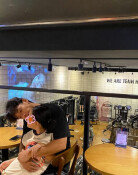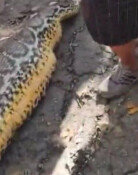New Movie: Zatoichi

Takeshi twists, dissects, fools, and ridicules the original story, leaving only the setup intact that he is a blind swordsman, genius gambler and massager. He completed this movie, a bloodstained comedy dancing precariously on a blade of a sword that won him a directors award at the Venice Film Festival last year.
I cannot help but wonder about two things about the movie. The secret codes of Kitano Takeshi lie in the answers to these questions.
- Why is Zatoichi blond?
The sole message that Takeshi carries throughout this movie about moviemaking is this: What about it? Its cool, thats all.
Zatoichi in the TV series wears black hair, an ordinary traditional outfit and carries a tan cane. However, Takeshi turns his hair blonde, the cane blood red, and the Kimono blue. Even his eyes are blue. In his previous movie, Dolls, he shows brilliant color aesthetics by using red, blue and yellow.
The movie is all about style. He slices his enemy with one stroke while holding the sword hilt upside down with the sword end pointing the ground. When he flourishes the sword twice, it only leaves an inequality sign (∠) on the body of an enemy. This is the fun part of being a swordsman, similar to Zorro leaves a Z as his signature.
The blood gushing out of the rascals bodies flowers beautifully like a dazzling flower. At this point, it is quite confusing whether or not the blood was a terrible thing or a beautiful thing.
- Why tap-dancing?
In the last scene, the whole staff gathers for a tap dance festival. Takeshi puts tap dancing in this historical drama and shows that his movie is a fun play full of performances and events.
He creates his own cinematographic rhythm and speed with cruel action and slapstick comedy mixed in. His sword dances as if participating in rhythmic gymnastics; the farmers ploughing and hammering reminds us of a Nanta performance.
The tumbling, bumbling comedy puts its foot in the middle of bloody scenes and cinematographic tension. Another swordsman, Hatori, merrily imagines himself attacking Zatoichi in his head. This scene tells the audience that this is just a movie, just enjoy it. The audience will find themselves associating the cruelty with comedy as they watch him accidentally chopping off his fellow swordsmans arm when taking out his sword, and as they watch the sword stuck in the ceiling falling down on the back of a rascal.
However, Zatoichis smile remains as cold as ever. He just enjoys the cinematographic situations with grins and laughter. There are only two kinds of characters in Takeshis movies: fun and good people, and fun and bad people.
Opens on January 30. Audience over 15.
Seung-Jae Lee sjda@donga.com






![[단독]김영훈 후보자, 과태료-세금 체납으로 12차례 차량 압류](https://dimg.donga.com/c/138/175/90/1/wps/NEWS/IMAGE/2025/07/10/131975137.1.jpg)
